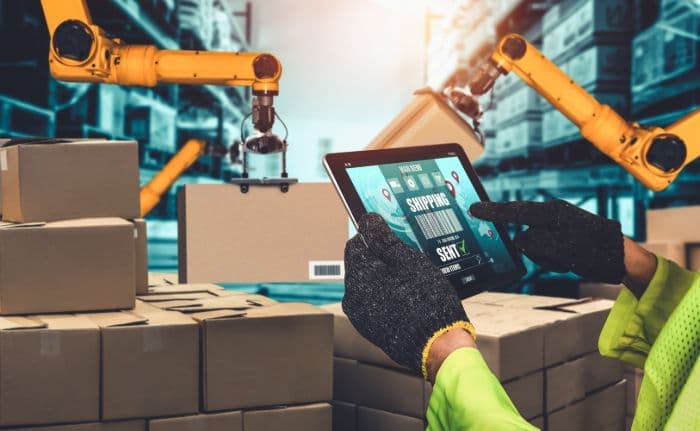AI-powered tools are transforming workplace logistics by automating manual tasks (which usually take longer than we want), improving inventory management, and seamlessly integrating with shipping carriers like FedEx and UPS.
In this blog entry, we’ll explore 5 AI-driven tools revolutionizing industrial logistics, highlighting their real-world applications and how your friends at Airpals contribute to the modernization of these processes.
Table of Contents:
- Tool #1: AI-Powered Logistics Workflow Software
- Tool #2: AI in Inventory Management Systems
- Tool #3: FedEx and UPS Integration Platforms
- Tool #4: Robotics in Supply Chain Management
- Tool #5: Route Optimization Software
- Key Takeaways: Best AI Tools for Logistics
- Conclusion: Revolutionize Your Workplace Logistics with Airpals
- Frequently Asked Questions
Tool #1: AI-Powered Logistics Workflow Software
Got a mountain of orders piling up? Does it feel like processing them will take all morning, and way too much coffee? You’re not alone.
Manual data entry, order processing, and document verification slow down logistics workflows, no matter how fast you type. AI-powered automation tools eliminate these inefficiencies by handling repetitive tasks, reducing errors, and improving productivity; so you can actually enjoy that coffee.
One example of AI-driven automation is Happy Robot, a startup revolutionizing workflow automation by streamlining operational tasks. Companies use it to automate processes that previously required constant manual intervention, freeing up time for more strategic work.
But AI isn’t just about automating tasks, it’s also transforming how businesses manage teams. AI-powered labor optimization software, like that developed by Covariant, helps warehouse operations improve picking, sorting, and staffing through intelligent robotics. Their system adapts in real-time, allowing companies like Radial and Otto Group to optimize labor resources and performance at scale.
Another powerful tool is Zapier. While there isn’t a platform solely dedicated to automating logistics and operations workflows, Zapier comes close. It integrates with supply chain and operations software, enabling seamless data transfers, automated notifications, and improved coordination.
Tool #2: AI in Inventory Management Systems
AI-powered inventory management systems use predictive analytics to optimize stock levels, prevent shortages, and improve accuracy. AI ops will not replace your workforce, but will definitely help you make the jump from working hard, to working smart.
Shoeby, a fashion retailer with over 240 stores, struggled with inventory imbalances due to fluctuating customer demand. By implementing AI-powered inventory management, Shoeby automated stock replenishment and demand forecasting. The AI-driven system improved inventory turnover by 4%, reduced excess stock by 2%, and increased total revenue by 3%.
These improvements enabled Shoeby to maintain optimal stock levels, minimize waste, and enhance operational efficiency, ensuring that each store had the right products available at the right time.
Solutions like ToolsGroup offer AI-driven inventory optimization that balances supply and demand with greater precision. Their platform automates forecasting, replenishment, and demand planning to help businesses maintain the right inventory levels and maximize service levels without overstocking.
Tool #3: FedEx and UPS Integration Platforms
Great news! Your business is thriving and orders are coming faster than ever before! But also, now you have to deal with a new problem. Managing multiple carriers can be overwhelming. Big numbers can mean bigger income, but without proper care, this growth can lead to errors and inefficiencies.
AI-powered integration platforms streamline multichannel operations by automating shipping label generation, all from one place and without having to be a 1990s hacker working from a 3 keyboard computer terminal (no matter how cool that might make you look. Trust me, I’ve tried). Now, when it comes to what Airpals AI-powered Shipping Tool can do for you, three main solutions come to mind:
- UPS and FedEx integration: Connect your existing carrier accounts directly to our platform, eliminating the need to switch between multiple carrier websites.
- Duplicate orders feature: Effortlessly create repeat shipments using saved shipping information, reducing manual input and improving efficiency.
- Centralized billing management: Consolidate all FedEx and UPS transactions in one dashboard, providing better financial oversight and operational clarity.
Many logistics processes, such as EDI data transfer from purchase orders to create a shipping label, still require manual intervention when working with carriers like FedEx and UPS. If this is your challenge, contact Airpals today to streamline your logistics workflow and improve efficiency.
Tool #4: Robotics in Supply Chain Management
We haven’t reached the spot where a thousand tiny robots join forces to change shape and move stuff around like in Big Hero 6, but AI-powered robots are transforming warehouse logistics by automating picking, packing, and sorting. These intelligent systems reduce processing time and enhance accuracy, giving us back the most important resource of all, time for ourselves.
One standout solution is Locus Robotics, whose autonomous mobile robots use AI to optimize picking routes, collaborate with warehouse staff, and increase throughput without reconfiguring existing infrastructure.
Many companies are deploying AI-driven robotic solutions to handle inventory movement, reducing labor costs and increasing operational speed, making their daily tasks a more streamlined and efficient process.
Tool #5: Route Optimization Software
Efficient route planning is essential for timely deliveries. AI-based route optimization software analyzes traffic patterns, weather conditions, and delivery schedules to identify the most efficient paths.
One powerful solution is OptimoRoute, which leverages machine learning to plan optimal delivery routes in real time. It dynamically adjusts for last-minute changes, helping businesses reduce driving time, fuel costs, and idle time, while improving customer satisfaction.
Key Takeaways: Best AI Tools for Logistics
- Happy Robot and Zapier help automate logistics workflows by reducing manual tasks like data entry and order processing.
- ToolsGroup improves inventory accuracy with AI-powered forecasting, replenishment, and stock optimization.
- Airpals AI Shipping Tool integrates with FedEx and UPS to centralize billing, automate labels, and simplify repeat orders.
- Locus Robotics boosts warehouse speed and accuracy using autonomous mobile robots for picking and sorting.
- OptimoRoute plans efficient delivery routes in real time, lowering fuel costs and improving customer satisfaction.
Conclusion: Revolutionize Your Workplace Logistics with Airpals
AI-powered tools are reshaping industrial workplace logistics, providing smarter, more efficient solutions to common challenges. By integrating advanced AI systems, businesses can optimize inventory, streamline workflows, and enhance shipping processes.
Struggling with carrier integrations, manual workflows, or inefficient shipping processes? If these are challenges in your business, Airpals can help. Our AI-powered solutions streamline operations, reduce manual tasks, and enhance logistics efficiency. Contact us today to see how Airpals can revolutionize your workplace logistics!

Frequently Asked Questions
What is workplace logistics, and why is it important?
Workplace logistics involves the strategic coordination of resources, personnel, and technology to ensure smooth supply chain operations, reducing delays and enhancing efficiency in industrial environments.
What are the common challenges in workplace logistics that AI can solve?
AI addresses inventory inaccuracies, workflow inefficiencies, nuances that arise when working with external carriers, and improving overall logistics performance.
How do AI in inventory management systems work?
AI-driven inventory management uses real-time data and predictive analytics to optimize stock levels, reduce waste, and improve supply chain accuracy.
Why is automation important in logistics?
Automation reduces manual labor, minimizes errors, increases efficiency, and enhances productivity in workplace logistics.
Why should businesses invest in AI tools for workplace logistics?
AI-powered tools streamline operations, lower costs, and improve overall supply chain management, giving businesses a competitive edge.
How does Airpals contribute to AI-driven workplace logistics solutions?
Airpals offers AI-powered workflow automation, and carrier integrations, making logistics operations more efficient and reliable, and a much friendlier online user interface.




